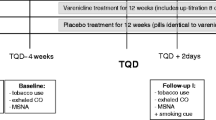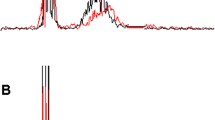Abstract
The effects of tobacco smoking and β-blockade on psychophysiological measures, i.e., heart rate (HR), blood pressure (BP), skin conductance (SC), and sensitivity to electrical pain stimulation was studied in a group of 33 male moderate smokers. Using a method of limits threshold determination technique, measures of pain threshold (PT), and tolerance level (TL) were obtained. The results were analyzed in relation to smoking habits, personality measures, and subjective effects. There was no significant effect of smoking on pain sensitivity. Smoking caused a physiological activation as indicated by an increase in HR and systolic BP. β-Blockade counteracted the smoking-induced increase in HR and systolic BP, but did not influence PT or TL. Subjective effects of smoking were not affected by β-blockade. The findings suggest that physiological activation is not related to effects of smoking on pain.
Similar content being viewed by others
References
Agué C (1973) Nicotine and smoking: Effects upon subjective changes in moods. Psychopharmacologia 30:323–328
Agué C (1974) Cardiovascular variables, skin conductance and time estimation: Changes after the administration of small doses of nicotine. Psychopharmacologia 37:109–125
Armitage AK (1978) The role of nicotine in the tobacco smoking habit. In: Thornton RE (ed) Smoking behaviour. Churchill Livingstone, London, pp 229–243
Ashton H, Millman JE, Telford R, Thompson JW (1974) The effect of caffeine, nitrazepam and cigarette smoking on the contingent-negative variation in man. Electroencephalogr Clin Neurophysiol 37:59–71
Barrett JE (1975) Sjöbring's personality dimensions: Norms for some american populations. Acta Psychiatr Scand 52:107–115
Bayliss PFG, Duncan SM (1975) The effects of atenolol (Tenormin) and methyl-dopa on simple tests of central nervous function. Br J Clin Pharmacol 2:527–531
Betts TA (1977) The psychomotor effects of atenolol and other antihypertensive agents. Postgrad Med J 53:157–161
Bowen ME (1969) Response to smoking in the presence of anxiety-eliciting cues. PhD dissertation, University of Illinois
Carruthers M (1976) Modification of the noradrenaline-related effects of smoking by β-blockade. Psychol Med 6:251–256
Dubren R (1976) The effect of smoking on anxiety. Diss Abstr Int 36:5786
Elliot RA, Thysell R (1968) A note on smoking and heart rate. Psychophysiology 5:280–283
Fagerström KO, Götestam KG (1977) Increase of muscle tonus after tobacco smoking. Addict Behav 2:203–206
Frankenhaeuser M, Myrsten AL, Wazak M, Neri A, Post B (1968) Dosage and time effects of cigarette smoking. Psychopharmacologia 13:311–319
Frankenhaeuser M, Myrsten AL, Post B (1970) Psychophysiological reactions to cigarette smoking. Scand J Psychol 11:237–245
Friedman J, Horvath T, Mears R (1974) Tobacco smoking and a stimulus barrier. Nature 248:455–456
Fuller RGC, Forrest DW (1977) Cigarette smoking under relaxation and stress. Ir J Psychol 3:165–180
Gilbert DG (1979) Paradoxical tranquilizing and emotion-reducing effects of nicotine. Psychol Bull 86:643–661
Glad W, Adesso VJ (1976) The relative importance of socially induced tension and behavioral contagion for smoking behavior. J Abnorm Psychol 85:119–121
von Graffenried B, Adler R, Abt K, Nuesch E, Spiegel R (1978) The influence of anxiety and pain sensitivity on experimental pain in man. Pain 4:253–263
Grimm L, Kanfer FH (1976) Tolerance of aversive stimulation. Behavior Therapy 7:593–601
Hall RA, Rappaport M, Hopkins HK, Griffin R (1973) Tobacco and evoked potential. Science 180:212–214
Heidbreder E, Pagel G, Röckel A, Heidland A (1978) Beta-adrenerge Blockade — ein stressprotektives Prinzip? Meto-prololwirkung auf Vigilita and bei psychischem Stress. Herzkreislauf 5:222–229
Lacey JI, Lacey BC (1970) Some autonomic-central nervous system interrelationships. In: Black P (ed) Physiological correlates of emotion. Academic, New York, pp 205–227
Larson PS, Finnegan JK, Haag HB (1950) Observations on the effect of cigarette smoking on the fusion frequency of flicker. Clin Invest 29:483–485
Levander SE (1979) Psychophysiological differentiation within criminal groups: An approach to the study of psychopathy. MD thesis, Stockholm: NEA-print
Levander SE, Gillner A (1982) Metipranolol and propranolol: No CNS effects of a single oral dose. Psychopharmacology 76:359–366
Mangan GL, Golding J (1978) An enhancement model of smoking maintenance? In: Thornton RE (ed) Smoking behavior. Physiological and psychological influences. Churchill Livingstone, Edinburgh, pp 87–114
Mueser K, Waller D, Levander SE, Schalling D (1980) Smoking and pain: A method of limits and sensory decision theory analysis.
Myrsten AL, Post B, Frankenhaeuser M, Johansson G (1972) Changes in behavioral and physiological activation induced by cigarette smoking in habitual smokers. Psychopharmacologia 27:305–312
Myrsten AL, Andersson K, Frankenhaeuser M, Mårdh A (1975) Immediate effects of cigarette smoking as related to different smoking habits. Percept Mot Skills 40:515–523
Nesbitt PD (1973) Smoking, physiological arousal and emotional response. Pers Soc Psychol 25:137–144
Philips C (1971) The EEG changes associated with smoking. Psychophysiology 8:64–74
Schalling D (1971) Tolerance for experimentally induced pain as related to personality. Scand J Psychol 12:271–281
Schalling D (1977) The trait-situation interaction and the physiological correlates of behavior. In: Magnusson D, Endler NS (eds) Personality at the cross-roads: Current issues in interactional psychology. Lawrence Erlbaum Associates (Wiley), Hillsdale NY, pp 129–141
Schalling D (1978) Psychopathy-related personality variables and the psychophysiology of socialization. In: Hare RD, Schalling D (eds) Psychopathic behavior: Approaches to research. Wiley, Chicester, pp 85–106
Schalling D, Edman G, Asberg M (1982) Impulsive cognitive style and inability to tolerant boredom: Psychobiological studies of temperamental vulnerability. In: Zuckerman M (ed) The biological bases of sensation-seeking and impulsivity. Lawrence Erlbaum Associates, Hillsdale NY (in press)
Seltzer CC, Friedman GD, Sieglaub AB, Collen MFM (1974) Smoking habits and pain tolerance. Arch Environ Health 29:170–172
Thomas CB, Murphy EA (1960) Circulatory responses to smoking in healthy young men. Ann NY Acad Sci 90:266–276
Ulett JA, Itil TM (1969) Quantitative electroencephalogram in smoking and smoking deprivation. Science 164:969–970
Vogel W, Broverman D, Kleiber EL (1977) Electroencephalographic responses to photic stimulation in habitual smokers and non-smokers. J Comp Physiol Psychol 91:418–422
Waller D (1975) Studier av rökmotivation (Studies on smoking motivation). Master's thesis (in Swedish), Department of Psychology, University of Stockholm
Waller D, Levander SE (1980) Smoking and vigilance: The effects of tobacco smoking on CFF as related to personality and smoking habits. Psychopharmacology 70:131–136
Author information
Authors and Affiliations
Rights and permissions
About this article
Cite this article
Waller, D., Schalling, D., Levander, S. et al. Smoking, pain tolerance, and physiological activation. Psychopharmacology 79, 193–198 (1983). https://doi.org/10.1007/BF00427811
Received:
Accepted:
Issue Date:
DOI: https://doi.org/10.1007/BF00427811




